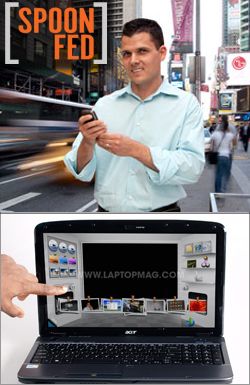What Would You Pay to Touch Your Notebook?

About a year ago I brought home a rugged laptop for testing, which just so happened to have a touchscreen. My then four-year-old daughter, who had just started to become accustomed to touchpads (yes, already), used the system to visit Playhouse Disney on the Web. She so thoroughly enjoyed tapping the screen on the new notebook that for the next couple of months she attempted to touch the display of any laptop I brought home, whether it had a touchscreen or not. And that just proves that touch is easier than using a touchpad—or a mouse—on a notebook. The question is how much consumers are willing to pay for this convenience, and what sort of interface or apps will make them choose one touch notebook over another.
There’s no doubt that support for multitouch gestures is one of the sexiest features of Windows 7, which will see its official launch next week. You'll be pinching to zoom in on Web pages, rotating photos, and—if a notebook has Microsoft's Touch Pack installed—playing the role of CNN anchor and spinning a virtual globe, as well as playing touch-friendly games. But in order to enjoy this capability, a notebook needs a capacitive multitouch display, which adds cost. For example, the HP TouchSmart tx2 (a 12-inch convertible tablet) and the Acer Aspire 5738PG (a 15.6-inch clamshell) start at $799. Toshiba’s new Satellite M505, a sleek 14-inch clamshell, costs $949. According to DisplaySearch, the average price of a laptop right now is $688, and netbooks average $361. More important, only the latter category is showing significant growth.
So how much does it cost consumers to go the touch route? One first-tier manufacturer told me recently that the cost of adding a touchscreen is about $100 for prospective buyers. These days 100 bucks is a hefty premium, but I suspect that consumers will be much more willing to fork over cash for touch than for a Blu-ray drive. And once that delta gets knocked down to $50 or less, it will only be a matter of time before touchscreens on notebooks become as commonplace as USB ports.
To bring that upsell price down, notebook makers need to prove to consumers (not to mention Amazon and Best Buy) that there is a true demand for touch computing. That’s why they’re adding touch-enabled software to their wares—some obviously bought off the shelf from a third party, and some homegrown. In our review of the Aspire 5738PG, we noted that the Acer Touch Portal interface looked a bit crude, and it crashed a few times. Meanwhile, Toshiba is dipping its toes in the touch waters with Toshiba LifeSpace, which consists of a virtual Bulletin Board and a film reel-looking app called ReelTime for flicking through thumbnails of recently used documents, photos, and more.
By comparison, HP is the current touch trailblazer. Although the design of its refreshed tx2 tablet is identical to its predecessor, the company has ported its robust TouchSmart widget platform from big, all-in-one desktops to mobile PCs. Not only does HP offer its own mini apps for music, photos, and weather, but the company is partnering with such big names as Hulu, Netflix, Pandora, and Twitter to create a touch computing ecosystem. There isn’t an app store for TouchSmart yet—you have to visit a Web site called TouchSmart Community to download new widgets—but I wouldn’t be surprised to see one added in the near future.
While there is plenty of debate as to whether touch makes sense on notebooks, especially clamshell designs, I predict that it will become much more prevalent and affordable in the coming months. And the impending arrival of Apple’s tablet will only further validate the category. But simply slapping touch on top of an existing system won’t be enough. Ultimately, consumers will gravitate towards those touchbooks whose software lets them get the most out of the technology.
Editor-in-chief Mark Spoonauer directs LAPTOP's online and print editorial content and has been covering mobile and wireless technology for over a decade. Each week Mark's SpoonFed column provides his insights and analysis of the biggest mobile trends and news. You can also follow him on twitter.
Stay in the know with Laptop Mag
Get our in-depth reviews, helpful tips, great deals, and the biggest news stories delivered to your inbox.
